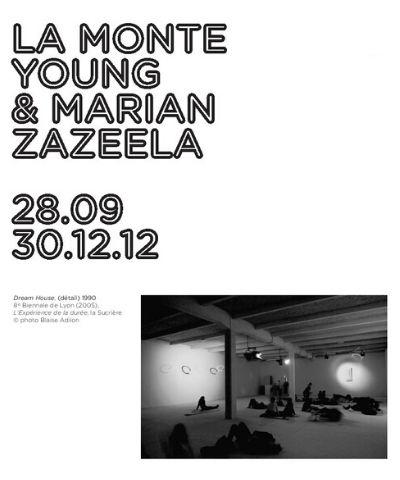
A mythical work, the Dream House is a sound and light installation created by La Monte Young, inventor of the concept of eternal music. The music moves the hanging mobiles, created by Marian Zazeela, in a barely perceptible way. For the listener, the experience is literally about immerging oneself in sound, observing its nuances. This is an experience conducive to reflection, whereupon the listener is as attentive to his/her inner being as he/she is to the music. Within this 500 m2 space, bathed in light and music, the visitor can enjoy unique sensations and an unusual experience of duration: everyone is invited to find their place in the work by sitting, or strolling at their own pace, appreciating the sound variations provoked by their own movements, however minimal these may be.
In 1998, macLYON invited Marian and La Monte to expose one of their Dream House sets (then belonging to the FNAC) in a final version in Lyon, on the museum’s third floor. The Lyon Dream House, as it is referred to by the artists, encompasses—according to Marian’s calculations, “a volume of 101,598 cubed feet of light”. It’s the biggest installation after the Harrison Street Building Dream House in New York. But “the Lyon house takes up 6,195 square feet whereas the New York one only takes up 4,900”1, she adds. Following this exhibition, at the request of the artists and in accordance with the FNAC, the work was deposited to the Lyon Museum of Contemporary Art “to the space that belongs to it”, according to La Monte Young. The piece entered the museum’s collection, under the inventory number 2007.12.5. The Lyon Dream House, combining sound, space and light, contains all of the terms or concepts common to Marian and La Monte’s collaborative work.
More information
“The concept of the Dream House is an idea that developed from my piece The Four Dreams of China which I composed in 1962 and which contains the concept of an infinite piece of music. (…) When I realized that a musical piece could permanently develop and evolve if it could have a permanent place where musicians could play every day, I came up wi th the idea of the Dream House: a building where musicians live and work, with a big space for performances and enough musicians so that there is always some people playing (…) In 1966, when I started experimenting wi th electronic music — my group The Theatre of Eternal Music had been in existence for a few years at that stage — I began to realize that working with musicians was very expensive. I therefore developed the idea of electronic sounds held over a long period of time, so that since then, I combine live and electronic music.”
— La Monte Young
For La Monte Young, every sound can be music as long as the existence of sound is conceivable. Founder of the American minimalist musical movement and above all, an exceptional musician, he is known for his interest in sustained notes and for his quest for just intonation. Drift Studies he has created since 1966 are musical pieces that marry these two aspects.
Produced and directed by Jacqueline Caux, the documentary Prism’s Colors, Mechanics of Time (96minutes, 2009) which investigates the musical Avant-Garde that has begun in the 1960s and is continuing in this early 21st century, is screened in the museum’s conference room throughout the exhibition.
This exhibition is dedicated to the memory of Daniel Caux (1940–2008).
















